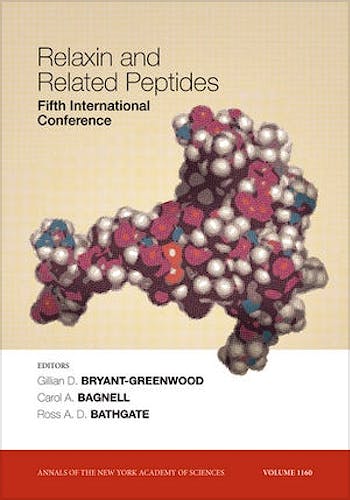

No hay productos en el carrito



Relaxin and Related Peptides
Bryant-Greenwood
1ª Edición Junio 2009
Inglés
Tapa blanda
352 pags
1000 gr
null x null x null cm
ISBN 9781573317214
Editorial WILEY
LIBRO IMPRESO
-5%
151,32 €143,75 €IVA incluido
145,50 €138,22 €IVA no incluido
Recíbelo en un plazo de
2 - 3 semanas
Description
Relaxin is a protein hormone, produced and secreted during pregnancy in mammalian
species, having superficial structural features resembling those of insulin.
Since its initial isolation from the ovaries of pregnant pigs in 1976, increasing
interest in relaxin has led to increased understanding of the chemistry, synthesis,
secretion, biological roles, mechanisms of action, and potential clinical applications
of relaxin in humans and domestic animals.
In pigs, rats, and mice, relaxin promotes growth and softening of the cervix,
enabling rapid and safe delivery of the fetuses. In these species relaxin also
promotes growth and development of the mammary apparatus.
Recently, biological effects of relaxin in the heart, kidney, liver, and brain have been identified, and these discoveries have triggered additional interest in possible clinical applications for relaxin. In 2002, a second form of relaxin, which is found primarily in the brain, was discovered.
Relaxin-like factor (also called insulin 3), which was discovered in 1993, is produced in the fetal testis and plays a major role in testicular descent during development. The recent identification of the receptors for both relaxin and relaxin-like factor has enabled more rigorous studies of the target tissues and mechanisms of action of these hormones.
This volume contains a description of recent advances and future research and clinical possibilities in the field of relaxin and related peptides.
Table of Contents
1. The "Hot Wires” of the Relaxin-Like Factor (Insl3).
2. Reversal of cardiac fibrosis and related dysfunction by relaxin: Experimental findings.
3. Prominent Role of Relaxin in Improving Post-Infarction Heart Remodelling. Clues From In Vivo and In Vitro Studies With Genetically Engineered Relaxin-Producing Myoblasts.
4. Degradation of Relaxin Family Peptides by Insulin-degrading Enzyme.
5. Relaxin Reduces Fibrosis in Models of Progressive and Established Hepatic Fibrosis.
6. Mutations in INSL3-RXFP2 genes in cryptorchid boys.
7. INSL3 plays a role in the balance between bone formation and resorption.
8. Identification of the Relaxin-Responsive Cells in the Human Choriodecidua at Term.
9. New roles for INSL3 in adults: regulation of bone metabolism and association of RXFP2 gene mutations with osteoporosis.
10. Role of relaxin in human osteoclastogenesis.
11. RXFP1 is expressed on sperm acrosome and relaxin stimulates the acrosomal reaction of human spermatozoa.
12. Probing the Functional Domains of Relaxin-3 and the Creation of a Selective Antagonist for RXFP3/GPCR135 over Relaxin Receptor RXFP1/LGR7.
13. ?1-Adrenergic Activation Upregulates Expression of Relaxin Receptor RXFP1 in Cardiomyocytes.
14. Relaxin in Endometriosis.
15. Relaxin/RXFP1 Signaling in Prostate Cancer Progression.
16. A Randomized, Double Blind, Placebo Controlled Trial of Relaxin for Cervical Ripening in Post-Date Pregnancies.
17. Relaxin: An endogenous renoprotective factor?.
18. Relaxin-3 and its role in neuroendocrine function.
19. Relaxin-Induced Changes in Renal Function and RXFP1 Receptor Expression in the Female Rat.
20. Bernard G. Steinetz Jr. ---A Most Tenacious Relaxinologist.
21. Relative Roles of the Epithelial and Stromal Tissue Compartment(s) in Mediating the Actions of Relaxin and Estrogen on Cell Proliferation and Apoptosis in the Mouse Lower Reproductive Tract.
22. Relaxin in Human Pregnancy.
23. Relaxin’s Involvement in ECM Homeostasis: Two Diverse Lines of Evidence.
24. EVALUATION of SYSTEMIC RELAXIN BLOOD PROFILES in HORSES as a MEANS of ASSESSING PLACENTAL FUNCTION in HIGH-RISK PREGNANCIES and RESPONSIVENESS to THERAPERUTIC STRATEGIES.
25. Relaxin Signaling in Uterine Fibroids.
26. Relaxin as a protective substance in the preserving solution for liver transplantation: Spectrophotometric in vivo imaging of local oxygen supply in an isolated perfused rat liver model.
27. Structural Properties of Relaxin Chimeras: NMR Characterization of the R3/I5 Relaxin Peptide.
28. An in vitro study of the protective effect of relaxin on brain tissue under ischemic stress.
29. Nuclear receptors, testosterone and post-translational modifications in human INSL3 promoter activity in testicular Leydig cells.
30. Relaxin Family Peptide Receptor 1 (RXFP1) Activation Stimulates the Peroxisome Proliferator-Activated Receptor Gamma.
31. Identification of Boar Testis as a Source and Target Tissue of Relaxin.
32. Relaxin Promotes Matrix Metalloproteinase-2 and Decreases Wnt/ß-Catenin Expression in the Neonatal Porcine Heart.
33. Conceptus Numbers do not Effect Blood Concentrations of Relaxin in the Rabbit.
34. Metabolic and Neuroendocrine Responses to RXFP3 Modulation in the CNS.
35. RXFP1 couples to the Gi3-G-PI3K-PKC pathway via the final 10 amino acids of the receptor C-terminal tail.
36. Relaxin activates multiple cAMP signaling pathway profiles in different target cells.
37. Perinatal Zearalenone Exposure Affects RXFP1, RXFP2, and Morphoregulatory Gene Expression in the Neonatal Porcine Uterus.
38. Development and Optimization of miRNA against relaxin-3.
39. Regulation of Rxfp2 (Lgr8) Expression in the Mouse Fetal Kidney by the Transcription Factor Pod1.
40. Addition of a carboxy-terminal green fluorescent protein (GFP) does not alter the binding and signaling properties of the relaxin family peptide receptor (RXFP) 3.
41. First clinical experience with intravenous recombinant human relaxin in compensated heart failure.
42. Relaxin and Maternal Lactocrine Programming of Neonatal Uterine Development.
43. Laser Microdissection of Neonatal Porcine Endometrium for Tissue Specific Evaluation of Relaxin Receptor (RXFP1) Expression in Response to Perinatal Zearalenone Exposure.
44. Biological Activity of Relaxin in Porcine Milk.
45. Investigations into the inhibitory effects of relaxin on renal myofibroblast differentiation.
46. Relaxin Concentrations in Serum and Urine of Endangered and Crazy Mixed-Up Species: New Methods, Uses and Findings.
47. Role of relaxin in the regulation of fibrosis in the lung: implications for airway remodeling in asthma.
48. Mechanism of relaxin receptor (LGR7/RXFP1) expression and function
© 2025 Axón Librería S.L.
2.149.0